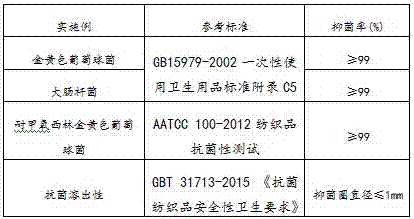Antibacterial nanofibers or master batches
A technology of nanofibers and antibacterial fibers, which is applied in fiber processing, conjugated synthetic polymer artificial filaments, filament/thread forming, etc., can solve the problems of poor resistance to rubbing and pollution resistance, poor mechanical properties, etc., and achieve antibacterial Performance, thermal stability improvement, water solubility enhancement effect
- Summary
- Abstract
- Description
- Claims
- Application Information
AI Technical Summary
Problems solved by technology
Method used
Image
Examples
Embodiment 1
[0039] First, an antimicrobial polymer resin solution is prepared.
[0040] Taking mass as the unit, dissolve 1wt% photosensitive molecule (model YG-03, the manufacturer is Qingdao Sunshine Biomedical Technology Co., Ltd.) into 10wt% formic acid (mass fraction ≥88%) solution, and the average molecular weight is 50,000 of 6wt% polymer resin was dissolved into 60wt% dimethylacetamide, slowly heated to 60-80°C at a heating rate of 2-5°C per minute, stirred for 60-120 minutes to fully dissolve the polyurethane, add 0.01 wt % additive and fully stirred to obtain an antibacterial polyurethane electrospinning solution.
[0041] Next, the antibacterial polyurethane electrospinning solution was electrospun at a spinning speed of 12 ml / h and a voltage of 15 kV.
[0042] Finally, the obtained electrospinning fibers are dried at a temperature of 60° C. for 0.1-4 hours to remove the residual organic solvent to prepare antibacterial nanofibers.
Embodiment 2
[0044] First, an antimicrobial polymer resin solution is prepared.
[0045] Taking mass as the unit, dissolve 5wt% photosensitive molecule (model YG-01, the manufacturer is Qingdao Sunshine Biomedical Technology Co., Ltd.) into 10wt% formic acid (mass fraction ≥88%) solution, and the average molecular weight is 50,000 of 6wt% polymer resin was dissolved into 60wt% dimethylacetamide, slowly heated to 60-80°C at a heating rate of 2-5°C per minute, stirred for 60-120 minutes to fully dissolve the polyurethane, add 0.01 wt % additive and fully stirred to obtain an antibacterial polyurethane electrospinning solution.
[0046] Next, the antibacterial polyurethane electrospinning solution was electrospun at a spinning speed of 12 ml / h and a voltage of 15 kV.
[0047] Finally, the obtained electrospinning fibers are dried at a temperature of 60° C. for 0.1-4 hours to remove the residual organic solvent to prepare antibacterial nanofibers.
Embodiment 3
[0049] First, an antimicrobial polymer resin solution is prepared.
[0050] Taking mass as the unit, dissolve 10wt% photosensitive molecule (model YG-03, the manufacturer is Qingdao Sunshine Biomedical Technology Co., Ltd.) into 10wt% formic acid (mass fraction ≥88%) solution, and the average molecular weight is 50,000 of 6wt% polymer resin was dissolved into 60wt% dimethylacetamide, slowly heated to 60-80°C at a heating rate of 2-5°C per minute, stirred for 60-120 minutes to fully dissolve the polyurethane, add 0.01 wt % additive and fully stirred to obtain an antibacterial polyurethane electrospinning solution.
[0051] Next, the antibacterial polyurethane electrospinning solution was electrospun at a spinning speed of 12 ml / h and a voltage of 15 kV.
[0052] Finally, the obtained electrospinning fibers are dried at a temperature of 60° C. for 0.1-4 hours to remove the residual organic solvent to prepare antibacterial nanofibers.
PUM
| Property | Measurement | Unit |
|---|---|---|
| Diameter | aaaaa | aaaaa |
Abstract
Description
Claims
Application Information
 Login to View More
Login to View More - R&D
- Intellectual Property
- Life Sciences
- Materials
- Tech Scout
- Unparalleled Data Quality
- Higher Quality Content
- 60% Fewer Hallucinations
Browse by: Latest US Patents, China's latest patents, Technical Efficacy Thesaurus, Application Domain, Technology Topic, Popular Technical Reports.
© 2025 PatSnap. All rights reserved.Legal|Privacy policy|Modern Slavery Act Transparency Statement|Sitemap|About US| Contact US: help@patsnap.com



